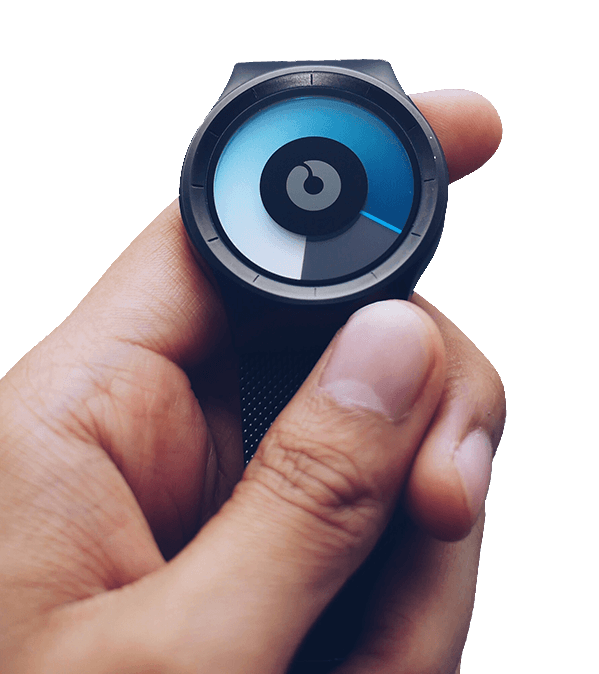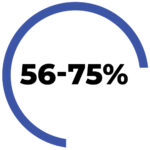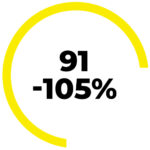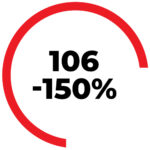
For all our training, we use PULSE ZONES, as a measuring tool, to understand what one's starting point is under different intensities. However, we use a WATT scale for indoor spinning (INDOOR BIKE).
The primary difference between the two methods is that when measuring watts, you get a precise measurement of the effect you step on the pedals with. Whereas heart rate is an indication of how much your body is under stress. With heart rate training, it is not just about the intensity you train with, but also whether you are sick, the temperature, the humidity, how warm you are wearing clothes, how rested/tired you are. To be precise, we use the term Functional Threshold Power (FTP), which is the maximum stable Watt power a cyclist can pedal for one hour (However, we test at 20 min all-out and multiply the average Watt figure by 0.95). Watts are not the same every time, but are a direct reading of the power you pedal with.
Since it is accurate, you can better use it to compare intervals, hill sprints, training sessions, races, etc. You also get the opportunity to see the development of your strength, which is not possible with heart rate, as it will be in the same range even if you pedal with more watts because you have become stronger. Your wattmeter gives you feedback directly opposite to your heart rate, which can easily be 10, 20 and often more than 30 seconds behind the measurement and actual heart rate.
Wattmeters on bicycles cost several thousand kroner, although prices are on the way down to a rent where more people can participate. /tri club denmark clearly recommends, if you have the means, to use a wattmeter in your training on the bike. Recently, there have also been wattmeters for running, including the products STRYD or SHFT.

– based on Functional Threshold Power FTP training (Tomahawk spinning bikes)

This is a very easy pace that you can maintain for hours. Often used for warming up and cooling down. When working in the white zone, it is very important that you feel the training is comfortable. The focus should not be on watts, heart rate or speed, but it should be nice. It must not be more difficult than you need to be able to hold a normal conversation.

Here you will start to feel that you are working. However, you must still feel that you can work here for many hours. intensity. It must still be possible to hold a conversation, albeit with more difficulty.

Here, the intensity is increased to be able to last for a shorter time (1 – 3 hours). Greater focus is required here. The breathing is more pressured, but you will especially feel that the muscles are more the limiting factor. This intensity will clearly be the most used on all fitness dk's cycling teams.

Yellow zone is an intensity you can maintain from 10-60 minutes. Training will typically take place in shorter intervals such as 2-8 min. You will have the feeling that the muscles are "burning", but not to a greater degree than if you can maintain the intensity for longer intervals. Conversation can only take place with words and not sentences.

Red zone is short interval training. This means that you cannot sustain this intensity for more than a maximum of about 10 minutes. Intervals will primarily last 1-5 minutes, and there will be a burning sensation in the muscles. When you're doing red zone training, it's extremely important that you finish the workout feeling like you could have completed another interval. It is very important not to work too hard. Red zone are NOT all-out intervals.
/tri club denmark I Nygårdsvej 7A, 3rd floor I 2100 Copenhagen Ø. I info@tri-club.dk In CVR: 35187235
| Cookie | Varighed | Beskrivelse |
|---|---|---|
| cookielawinfo-checkbox-analytics | 11 months | This cookie is set by the GDPR Cookie Consent plugin. The cookie is used to store the user consent for the cookies in the category "Analytics". |
| cookielawinfo-checkbox-analytics | 11 months | This cookie is set by the GDPR Cookie Consent plugin. The cookie is used to store the user consent for the cookies in the category "Analytics". |
| cookielawinfo-checkbox-functional | 11 months | The cookie is set by GDPR cookie consent to record the user consent for the cookies in the category "Functional". |
| cookielawinfo-checkbox-functional | 11 months | The cookie is set by GDPR cookie consent to record the user consent for the cookies in the category "Functional". |
| cookielawinfo-checkbox-others | 11 months | This cookie is set by the GDPR Cookie Consent plugin. The cookie is used to store the user consent for the cookies in the category "Other. |
| cookielawinfo-checkbox-others | 11 months | This cookie is set by the GDPR Cookie Consent plugin. The cookie is used to store the user consent for the cookies in the category "Other. |
| cookielawinfo-checkbox-necessary | 11 months | This cookie is set by the GDPR Cookie Consent plugin. The cookies are used to store the user consent for the cookies in the category "Necessary". |
| cookielawinfo-checkbox-necessary | 11 months | This cookie is set by the GDPR Cookie Consent plugin. The cookies are used to store the user consent for the cookies in the category "Necessary". |
| cookielawinfo checkbox performance | 11 months | This cookie is set by the GDPR Cookie Consent plugin. The cookie is used to store the user consent for the cookies in the category "Performance". |
| cookielawinfo checkbox performance | 11 months | This cookie is set by the GDPR Cookie Consent plugin. The cookie is used to store the user consent for the cookies in the category "Performance". |
| viewed_cookie_policy | 11 months | The cookie is set by the GDPR Cookie Consent plugin and is used to store whether or not the user has consented to the use of cookies. It does not store any personal data. |
| viewed_cookie_policy | 11 months | The cookie is set by the GDPR Cookie Consent plugin and is used to store whether or not the user has consented to the use of cookies. It does not store any personal data. |